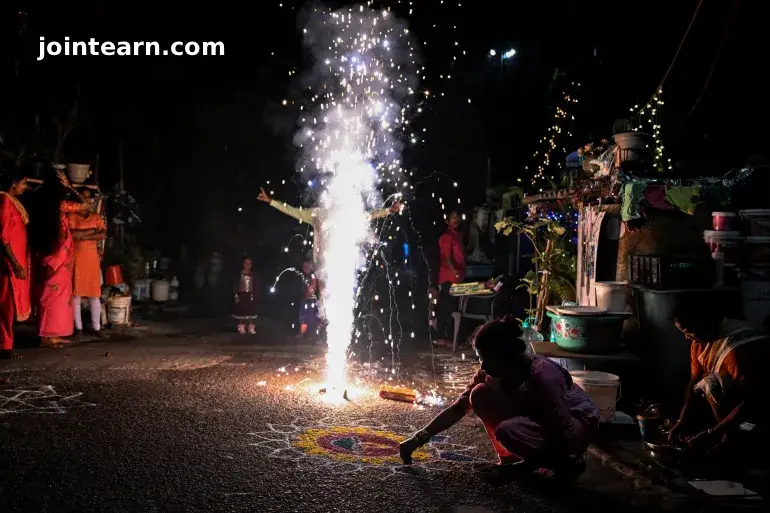
New Delhi Records ‘World’s Worst’ Air Quality After Diwali Festivities
The annual Diwali celebrations in India’s capital, New Delhi, have once again triggered a severe air pollution crisis, with air quality levels reaching the “hazardous” category — the worst in the world, according to air monitoring firm IQAir.
On Tuesday morning, the city’s Air Quality Index (AQI) hit 442, more than 59 times higher than the World Health Organization’s (WHO) recommended safety level for fine particulate matter (PM2.5).
This marks yet another year when the Hindu Festival of Lights has pushed New Delhi’s pollution to alarming levels, driven largely by fireworks, agricultural stubble burning, and stagnant winter weather conditions.
Fireworks, Traffic, and Crop Burning Worsen Smog
Despite partial restrictions imposed by the Supreme Court of India, residents across Delhi and its suburbs set off thousands of fireworks late into Monday night, creating dense clouds of smoke that mingled with existing industrial and vehicular pollution.
While the court had allowed only “green crackers” — fireworks designed to emit fewer pollutants — and restricted use to a three-hour window, local reports and social media posts showed widespread violations across the city.
The Central Pollution Control Board (CPCB) recorded an average AQI of 350, categorizing the city’s air as “very poor.” For comparison, CPCB defines an AQI of 0–50 as “good” and anything above 400 as “severe.”
Visibility Drops as PM2.5 Levels Soar
The concentration of PM2.5 particles — microscopic pollutants that penetrate deep into the lungs and bloodstream — surged to over 350 micrograms per cubic meter in several parts of Delhi, according to real-time monitoring stations.
These particles are known to cause respiratory illnesses, heart disease, and stroke. Hospitals across Delhi reported a rise in patients experiencing shortness of breath, asthma attacks, and irritation in the eyes and throat following the celebrations.
Photos and videos circulating online show major highways shrouded in thick smog, airports struggling with visibility, and commuters wearing masks to protect themselves from the toxic air.
Government Response and Weather Forecast
Authorities have warned that the city is unlikely to see major improvement in the coming days.
The Ministry of Earth Sciences said air quality is expected to remain in the “Poor to Very Poor” range, with AQI values between 201 and 400, due to low wind speeds that trap pollutants close to the ground.
In past years, Delhi has implemented emergency measures such as:
- Closing schools and construction sites
- Banning diesel vehicles
- Encouraging work-from-home policies
- Spraying water from anti-smog guns
Last year, similar smog conditions caused the AQI to spike above 1,700 in certain areas — a level considered life-threatening by global health experts.
Regional Impact: Lahore Ranks Second
India is not alone in facing hazardous air. Neighboring Lahore, Pakistan, ranked as the second most polluted city in the world on Tuesday with an AQI of 234.
Officials in Punjab province have blamed cross-border pollution from Indian crop fires, as well as local sources such as vehicle emissions and industrial smoke. Lahore’s government has announced an “emergency anti-smog plan”, including crackdowns on unregulated factories and farm fires.
Public Health and Environmental Concerns
Health experts warn that Delhi’s recurring air pollution crises could have severe long-term effects on residents, particularly children and the elderly.
Prolonged exposure to PM2.5 particles has been linked to reduced lung function, cardiovascular problems, and premature deaths.
Dr. Rajesh Sharma, a pulmonologist at Safdarjung Hospital, said,
“Each year, the post-Diwali period brings a spike in respiratory cases. The combination of fireworks, stagnant air, and existing pollution makes it a perfect storm for public health.”
Environmental groups have renewed calls for stronger enforcement of fireworks bans and transition to clean energy sources for transportation and industry.
Key Takeaways
- Delhi AQI hits 442, ranking as the worst in the world.
- Fireworks, traffic emissions, and crop burning are the main contributors.
- PM2.5 concentration is 59 times higher than WHO guidelines.
- Lahore ranks second globally for poor air quality.
- Authorities expect pollution to remain high for several more days.
Leave a Reply